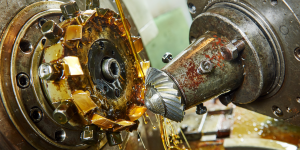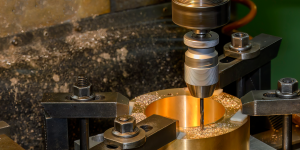One of the most crucial aspects of modern manufacturing is precision machining. Modern manufacturing utilizes complex and precise parts for diverse sectors through advanced methods and tools. Precision machining plays a key role in the quality, précision, and speed of a product.
Precision machining—how does it work?
Precision machining is the process of taking a piece of material and removing the precise amount of it in order to form the needed shape. CNC (Commande numérique par ordinateur) machine is used to make exact and precise cuts and movements according to the digital blueprints.
A detailed design or plan is converted into a computer program that tells the machine what to do. The machine, in order to shape and dimension the piece, uses drills, mills, and lathes to take away material.

Advantages of Precision Machining in Manufacturing
Among the numerous benefits of precision machining, the most notable one is the production efficacy of the manufacturing process. One of the essential benefits of the advanced technology is the accuracy and precision. Through precision machining, manufacturers are able to fabricate parts with tight tolerances and great accuracy and therefore, each part would fit into the final product perfectly.
Yet, another advantage of precision machining is cost cutting. An example of this is precision machining which requires specialized tools and work, but also can save money in the long run. High accuracy and precision of precision machining exclude material wastage, rework, and repair, which significantly decrease manufacturing costs.
Knowledge of Precision Machining Methods
- Usinage CNC: CNC machining is one of the most popular precision machining methods where it is a computer-controlled machine that removes material from a workpiece. Its precision, replicability, as well as adaptability, make it to be used in many applications.
- Electrical Discharge Machining (EDM): This nonconvention technology applies electrical sparks to remove material from a workpiece. It is able to cut very intricate and hard materials which traditional technologies cannot manage.
- Découpe au laser: An advanced laser tool can cut materials with great speed and accuracy. This laser is able to make clean cuts on metals, polymères, and composites alike.
- Waterjet Cutting: A jet of water containing abrasive particles creates a high-pressure stream that cuts materials. It can be found in metals, polymères, stones, and glass.
- Grinding: Abrasive wheels in precision machining are used for the removal of material from a workpiece. Several industries depend on it for finishing delicate surfaces and to get tight tolerances.
Selecting the Right Precision Machining Method for Your Project
A lot of things need to be taken into account when you are deciding on the precision machining technology that is the most suitable for your project. These are design complexity, material type, degree of precision, and surface finish. Tailoring the approach to the project is imperative for the most effective outcome.
A consultation with a precision machining professional before selecting a process is advised. Taking the advantage of their machining skills, a seasoned professional can give you important recommendations. They may be the ones to evaluate the requirements of a project and propose the most effective plan to reach the goal.
Importance of Precision Machining Quality Control
Precision machining requires quality control. It involves several steps to ensure each component fulfills requirements and standards. Quality control begins at design and continues throughout manufacture.
Precision machining requires quality control for accuracy and consistency. Manufacturers can detect deviations and flaws early and repair them to preserve precision by using stringent inspection methods. This prevents costly rework or scrap and ensures component quality.
Common Precision Machining Materials
Machining precision can be done on several materials as long as the job requires it. Precision machining employs different types of metals, polymères, composites and ceramics.
The mechanical features of aluminum, acier, and titanium made them popular in machining. Plastics are mostly used in precision machining for being lightweight, corrosion-resistant and electrical insulating.

Composites, which are formed by blending two or more elements, is being used in different industries. They have a distinct feature of having a strength-to-weight ratio and resistance to corrosion and fatigue.
High-demand precision machining projects that call for extreme toughness and wear resistance use ceramics that are both strong and heat-resistant.
Future Precision Machining Trends and Innovations
Technology and output as well as efficiency demand the development of precision machining. There are many trends and innovations which are going to change precision machining.
Artificial intelligence and machine learning algorithms are transforming the role of precision machining. These technologies allow the machines to learn from data, optimize the cutting parameters, and change in real-time for the sake of accuracy and efficiency.
Automation and robotics will also be decisive in the process of exact machining. Automation can do many operations over and over again, so there will be fewer human mistakes and higher efficiency. By using cobots, which are robots that can perform the same tasks as humans but with higher precision, precision machining is getting more and more efficient and safer.
The integration of the manufacturing process is another trend. The accuracy of machining is frequently combined with additive manufacturing (3D printing) to achieve precise, delicate parts.
Last but not least, precision machining is key to modern manufacturing. The advantages are improved accuracy, efficacité, lower costs, and maintaining the same level of quality. Manufacturers can use precision machining to their own benefit by studying the different techniques, considering project requirements, working together with specialists, implementing quality control measures, picking up corresponding materials and following the trends and innovations.
